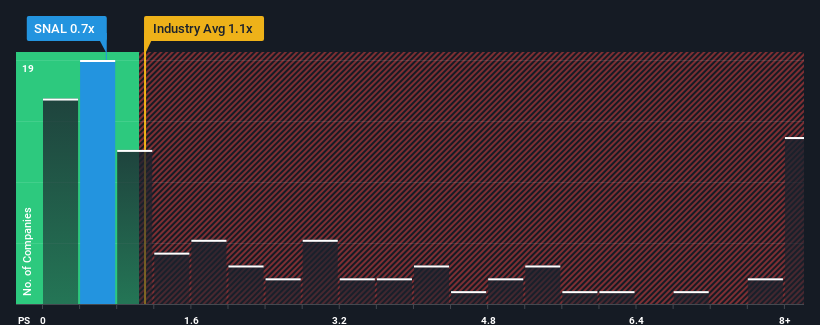- United States
- /
- Entertainment
- /
- NasdaqCM:SNAL
Slammed 25% Snail, Inc. (NASDAQ:SNAL) Screens Well Here But There Might Be A Catch

To the annoyance of some shareholders, Snail, Inc. (NASDAQ:SNAL) shares are down a considerable 25% in the last month, which continues a horrid run for the company. Instead of being rewarded, shareholders who have already held through the last twelve months are now sitting on a 48% share price drop.
In spite of the heavy fall in price, there still wouldn't be many who think Snail's price-to-sales (or "P/S") ratio of 0.7x is worth a mention when the median P/S in the United States' Entertainment industry is similar at about 1.1x. Although, it's not wise to simply ignore the P/S without explanation as investors may be disregarding a distinct opportunity or a costly mistake.
Check out our latest analysis for Snail

What Does Snail's Recent Performance Look Like?
Snail hasn't been tracking well recently as its declining revenue compares poorly to other companies, which have seen some growth in their revenues on average. One possibility is that the P/S ratio is moderate because investors think this poor revenue performance will turn around. If not, then existing shareholders may be a little nervous about the viability of the share price.
Want the full picture on analyst estimates for the company? Then our free report on Snail will help you uncover what's on the horizon.Is There Some Revenue Growth Forecasted For Snail?
There's an inherent assumption that a company should be matching the industry for P/S ratios like Snail's to be considered reasonable.
Taking a look back first, the company's revenue growth last year wasn't something to get excited about as it posted a disappointing decline of 42%. The last three years don't look nice either as the company has shrunk revenue by 62% in aggregate. Accordingly, shareholders would have felt downbeat about the medium-term rates of revenue growth.
Shifting to the future, estimates from the lone analyst covering the company suggest revenue should grow by 89% over the next year. Meanwhile, the rest of the industry is forecast to only expand by 12%, which is noticeably less attractive.
In light of this, it's curious that Snail's P/S sits in line with the majority of other companies. Apparently some shareholders are skeptical of the forecasts and have been accepting lower selling prices.
What Does Snail's P/S Mean For Investors?
With its share price dropping off a cliff, the P/S for Snail looks to be in line with the rest of the Entertainment industry. Using the price-to-sales ratio alone to determine if you should sell your stock isn't sensible, however it can be a practical guide to the company's future prospects.
Despite enticing revenue growth figures that outpace the industry, Snail's P/S isn't quite what we'd expect. When we see a strong revenue outlook, with growth outpacing the industry, we can only assume potential uncertainty around these figures are what might be placing slight pressure on the P/S ratio. This uncertainty seems to be reflected in the share price which, while stable, could be higher given the revenue forecasts.
Having said that, be aware Snail is showing 2 warning signs in our investment analysis, and 1 of those makes us a bit uncomfortable.
Of course, profitable companies with a history of great earnings growth are generally safer bets. So you may wish to see this free collection of other companies that have reasonable P/E ratios and have grown earnings strongly.
New: Manage All Your Stock Portfolios in One Place
We've created the ultimate portfolio companion for stock investors, and it's free.
• Connect an unlimited number of Portfolios and see your total in one currency
• Be alerted to new Warning Signs or Risks via email or mobile
• Track the Fair Value of your stocks
Have feedback on this article? Concerned about the content? Get in touch with us directly. Alternatively, email editorial-team (at) simplywallst.com.
This article by Simply Wall St is general in nature. We provide commentary based on historical data and analyst forecasts only using an unbiased methodology and our articles are not intended to be financial advice. It does not constitute a recommendation to buy or sell any stock, and does not take account of your objectives, or your financial situation. We aim to bring you long-term focused analysis driven by fundamental data. Note that our analysis may not factor in the latest price-sensitive company announcements or qualitative material. Simply Wall St has no position in any stocks mentioned.
About NasdaqCM:SNAL
Snail
Researches, develops, markets, publishes, and distributes interactive digital entertainment for consumers worldwide.
Reasonable growth potential with adequate balance sheet.
Similar Companies
Market Insights
Community Narratives



